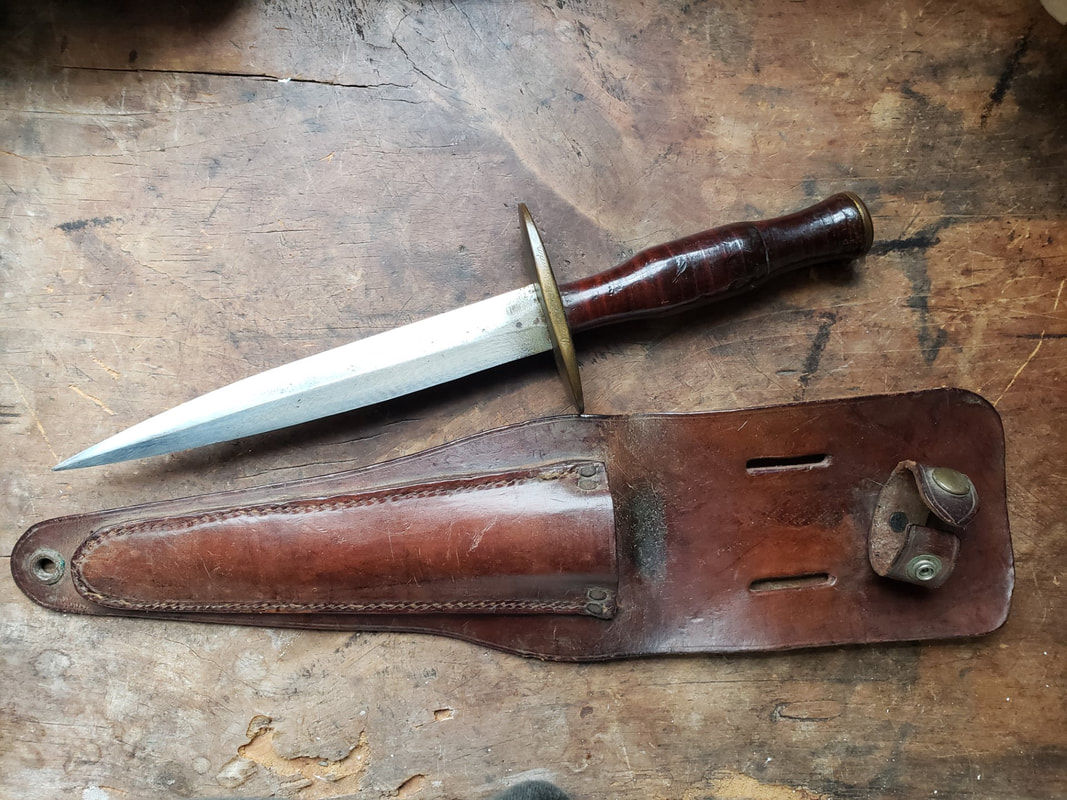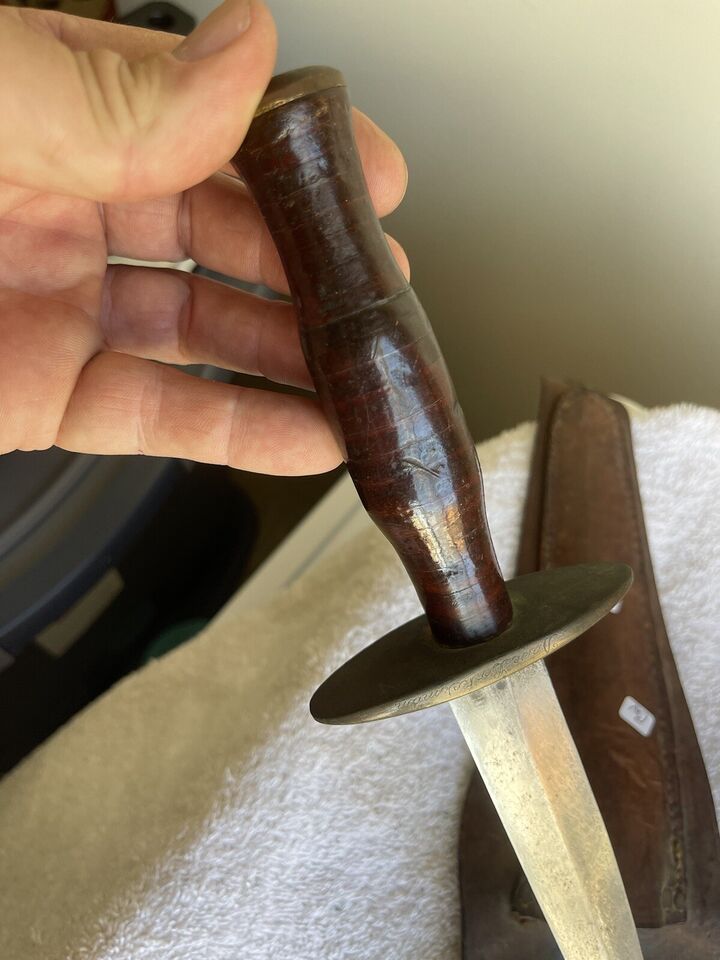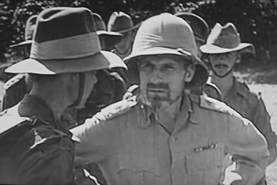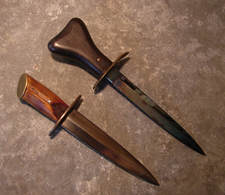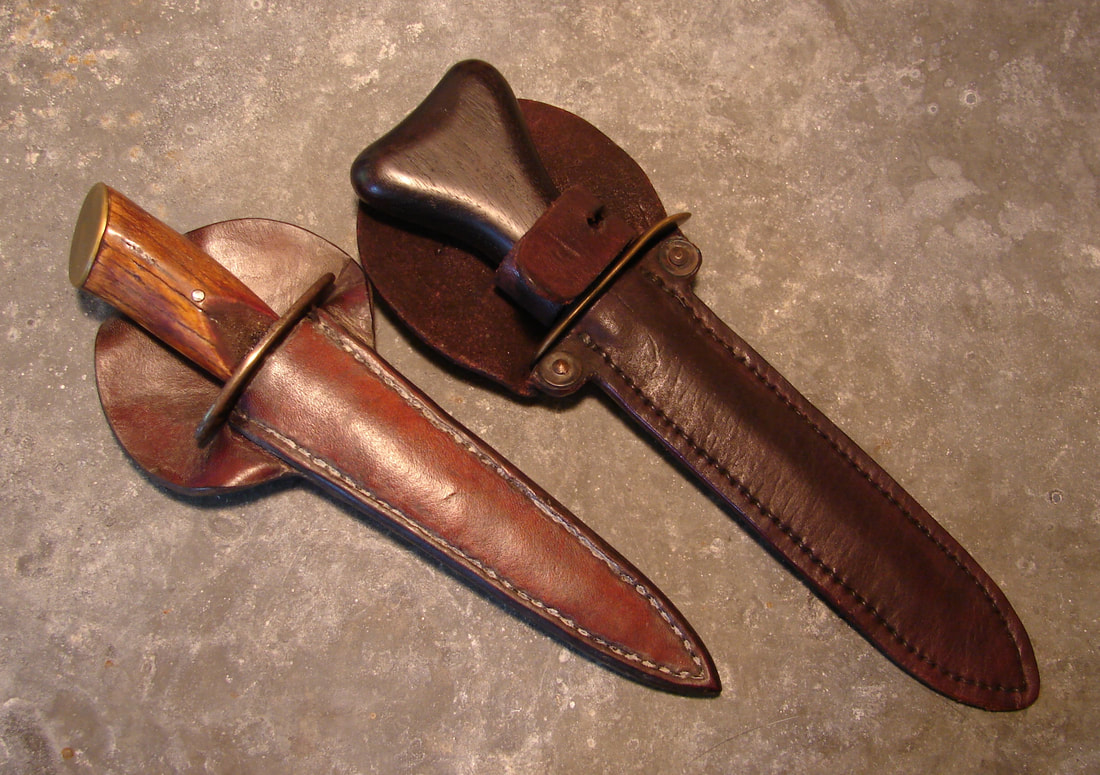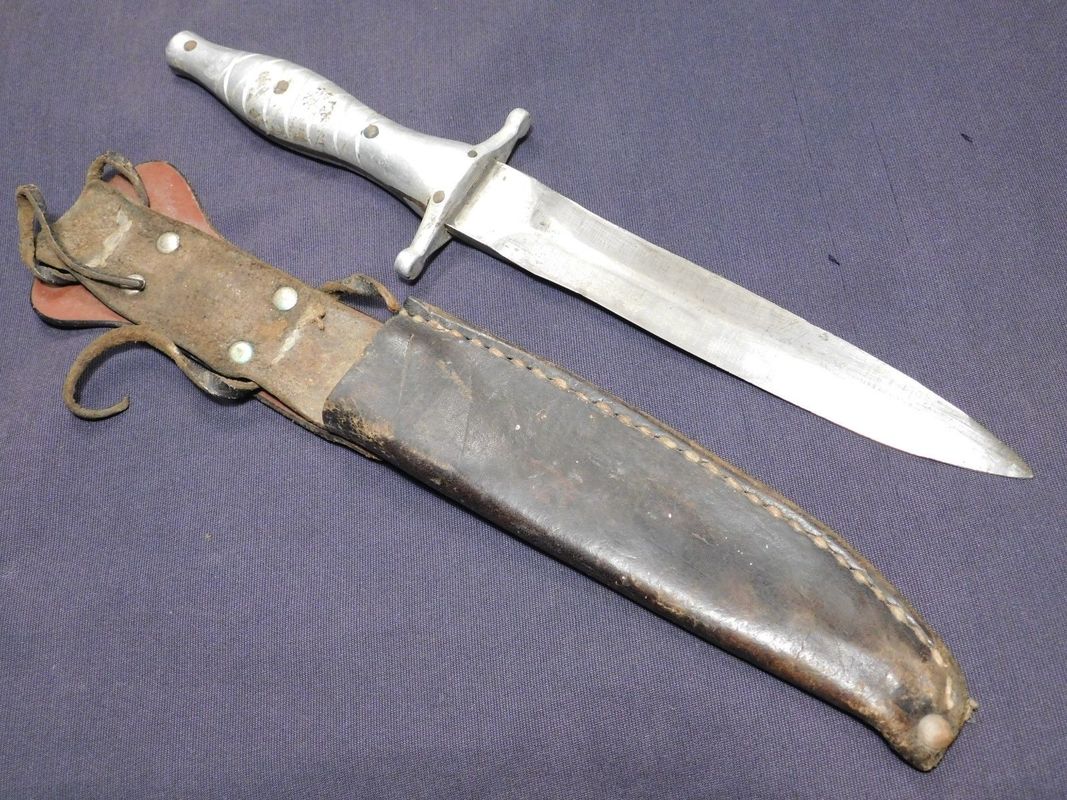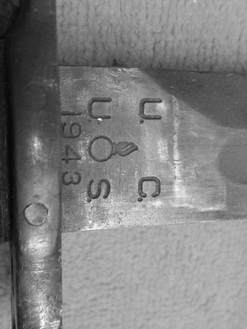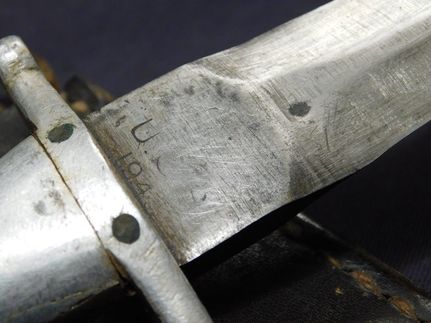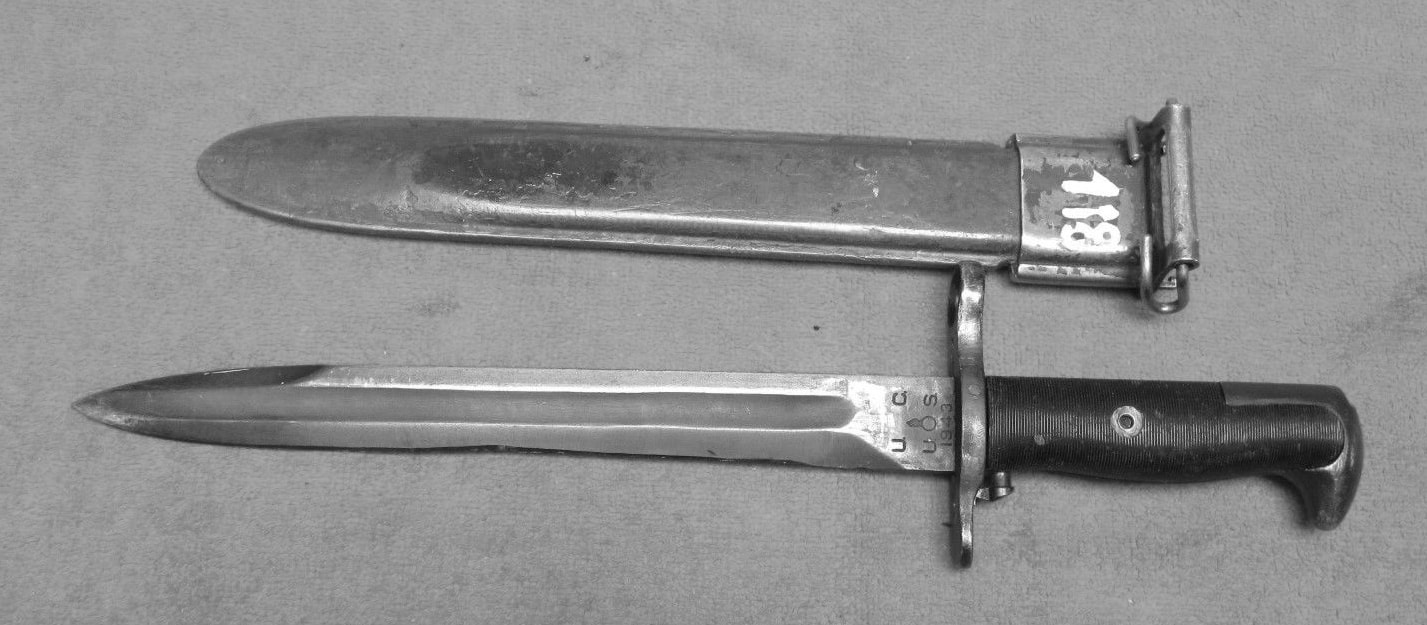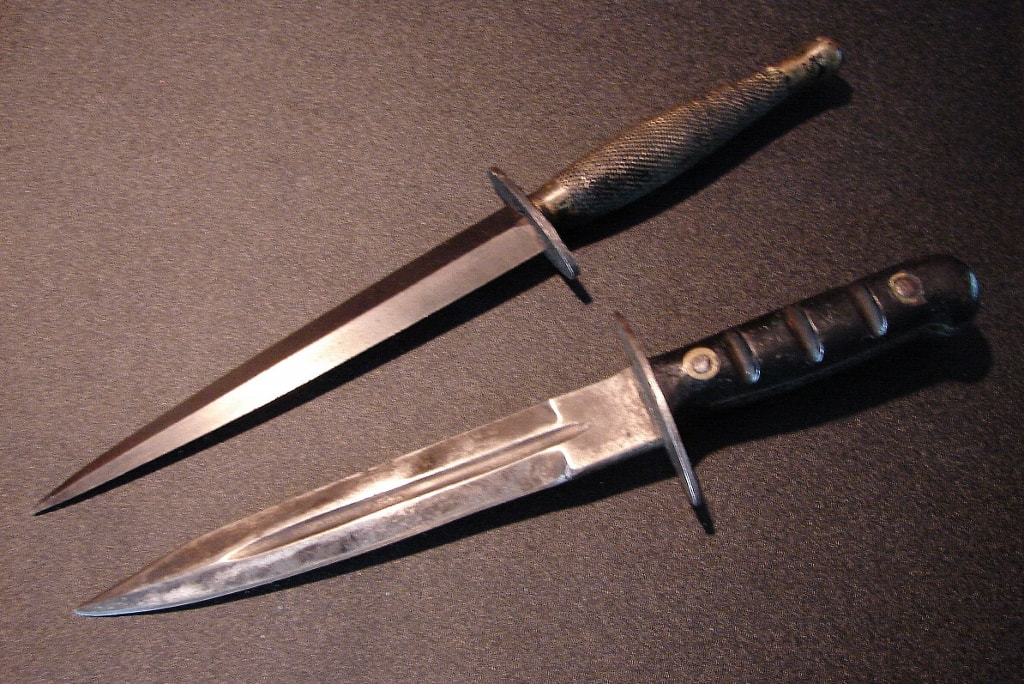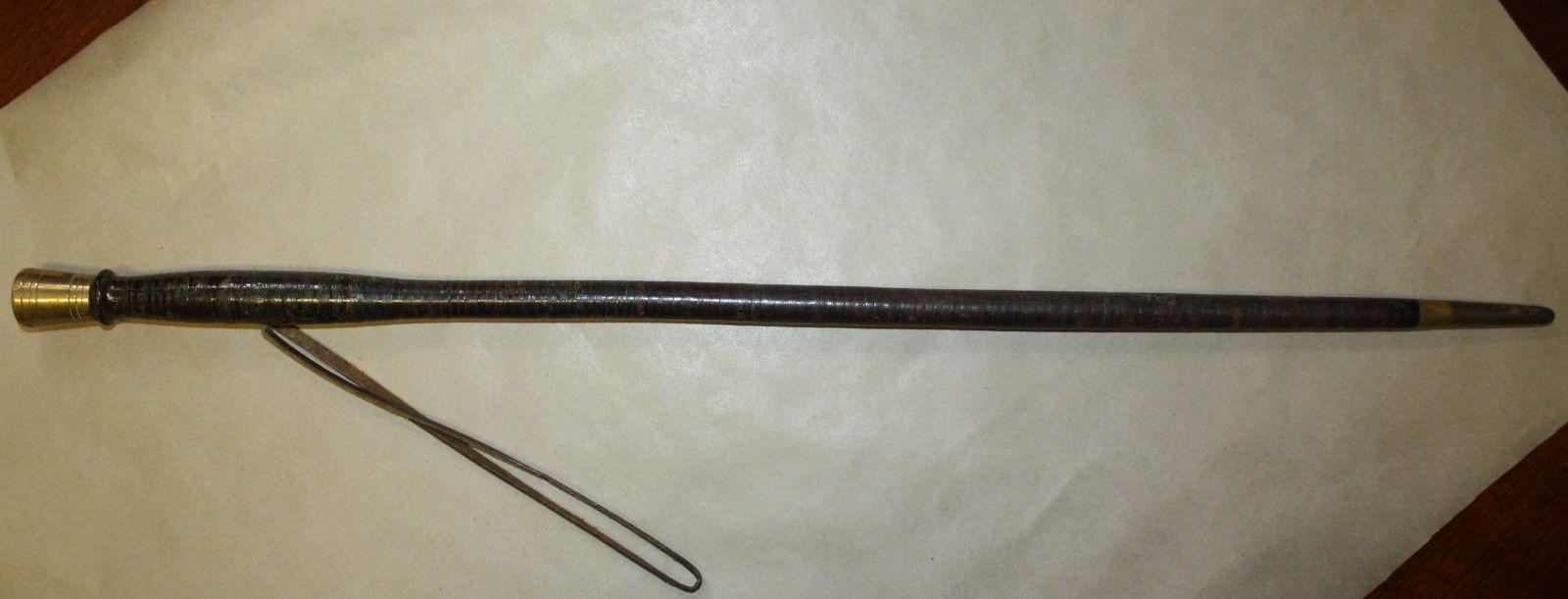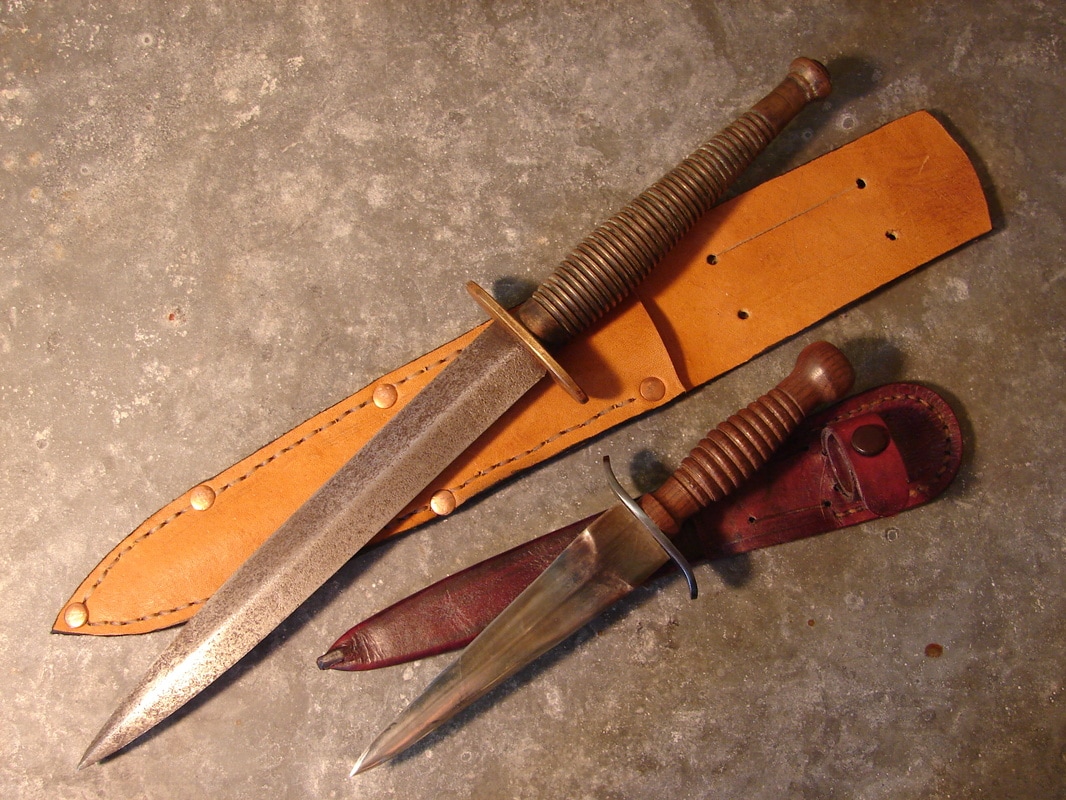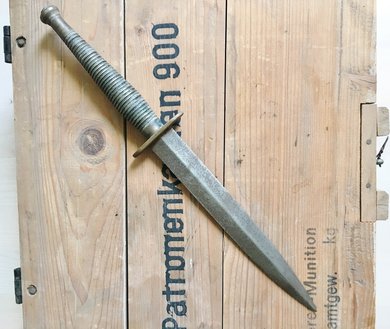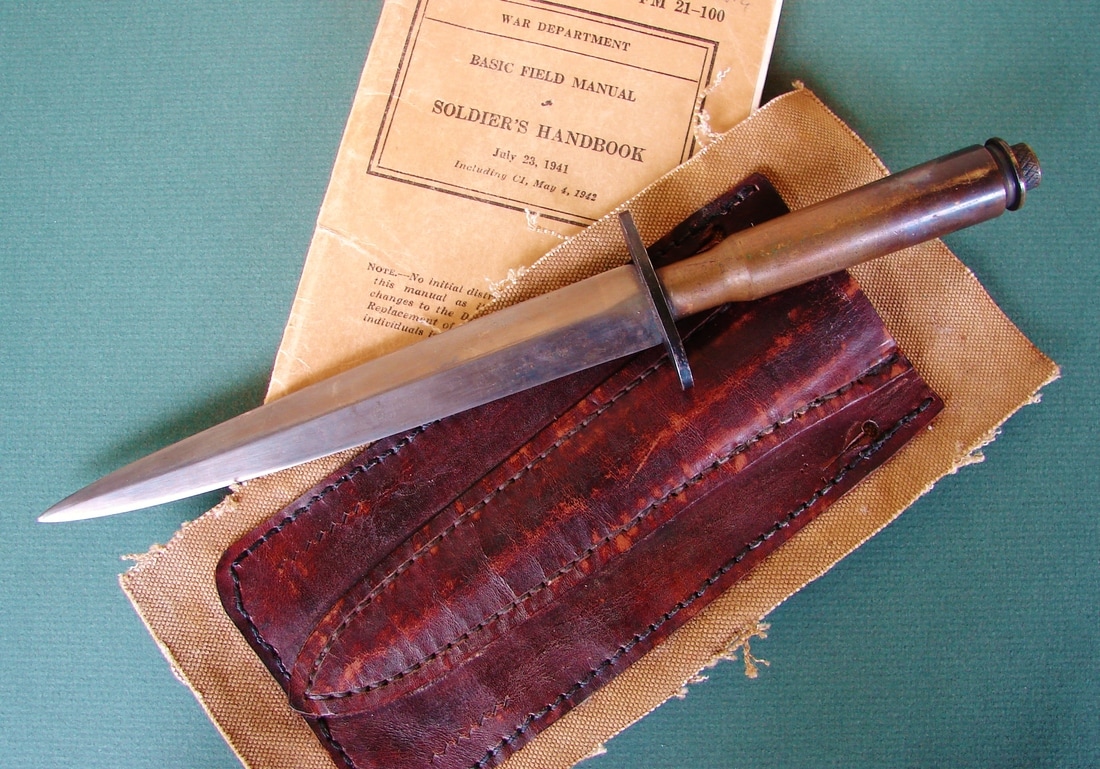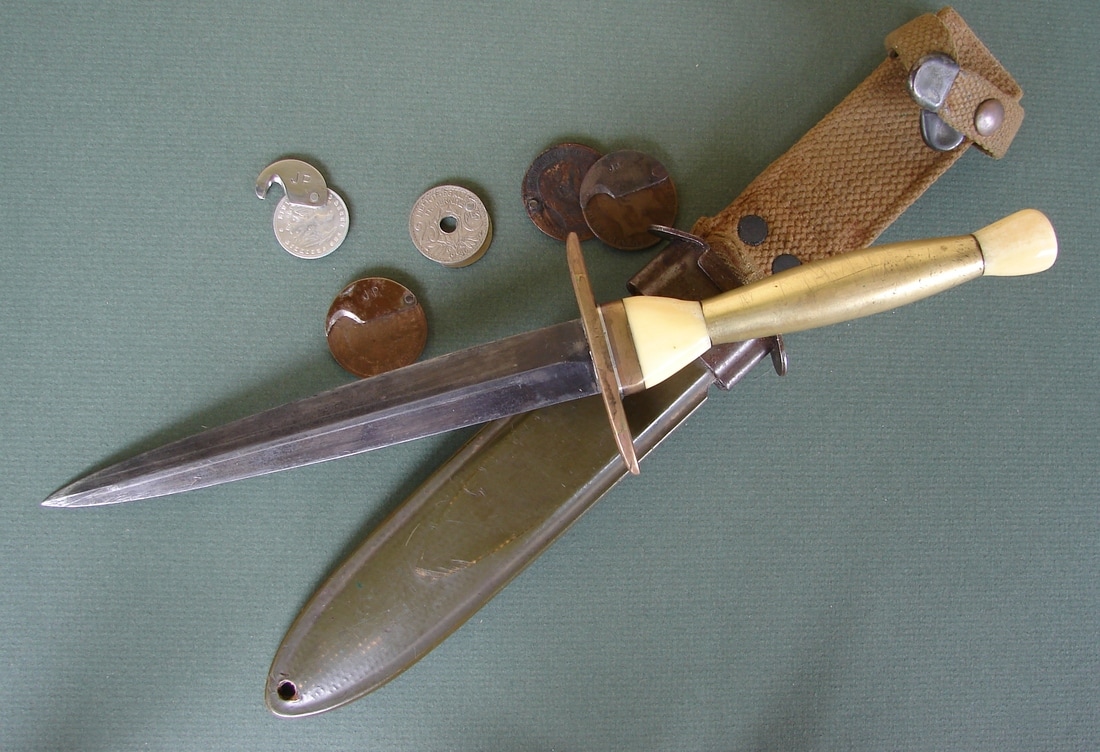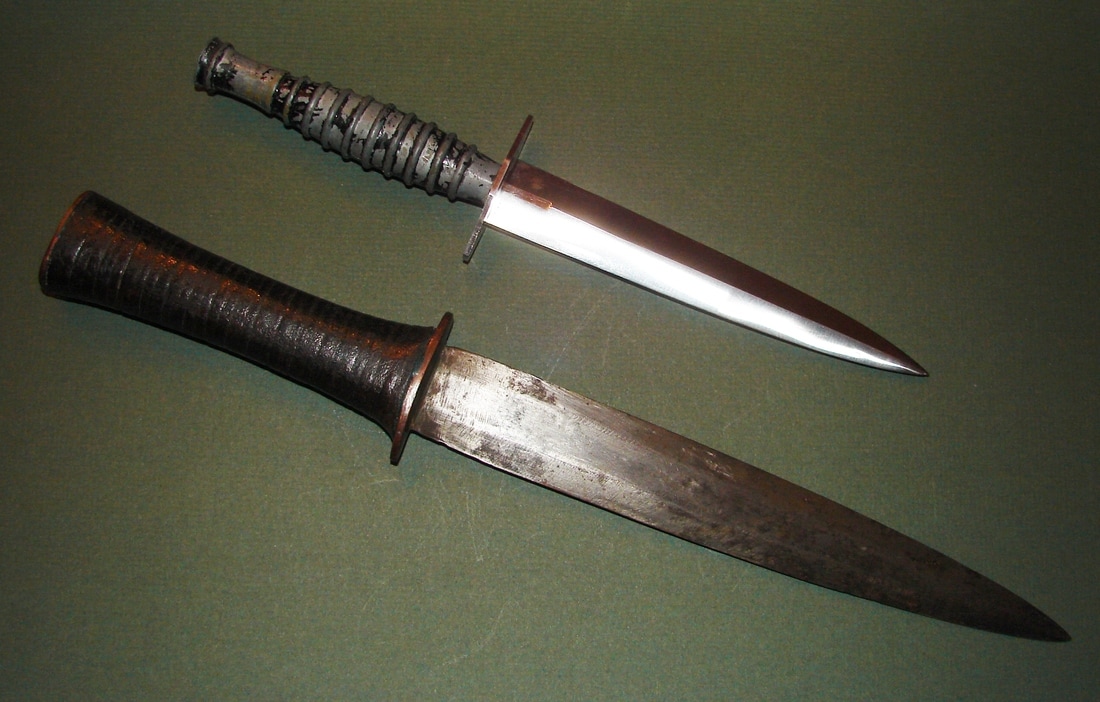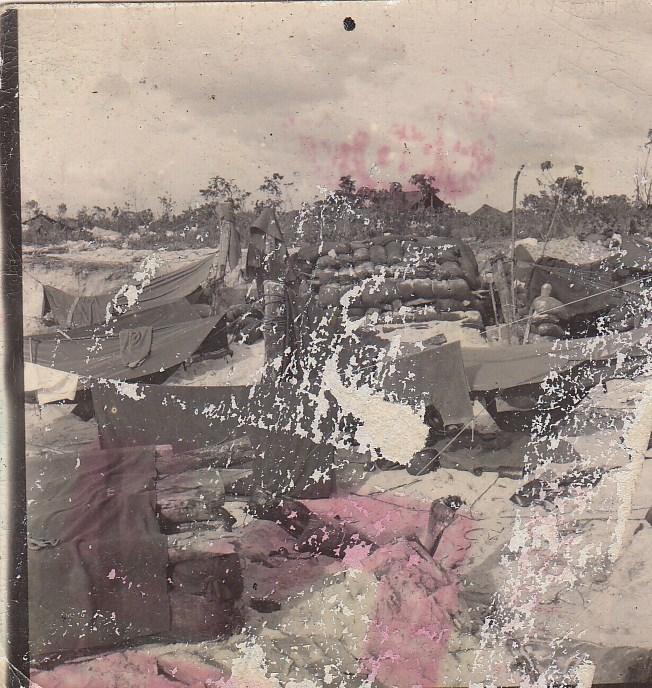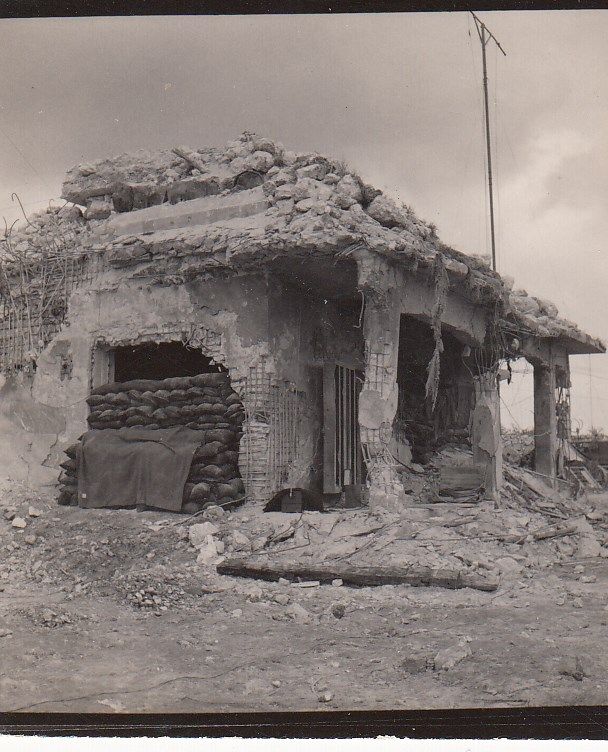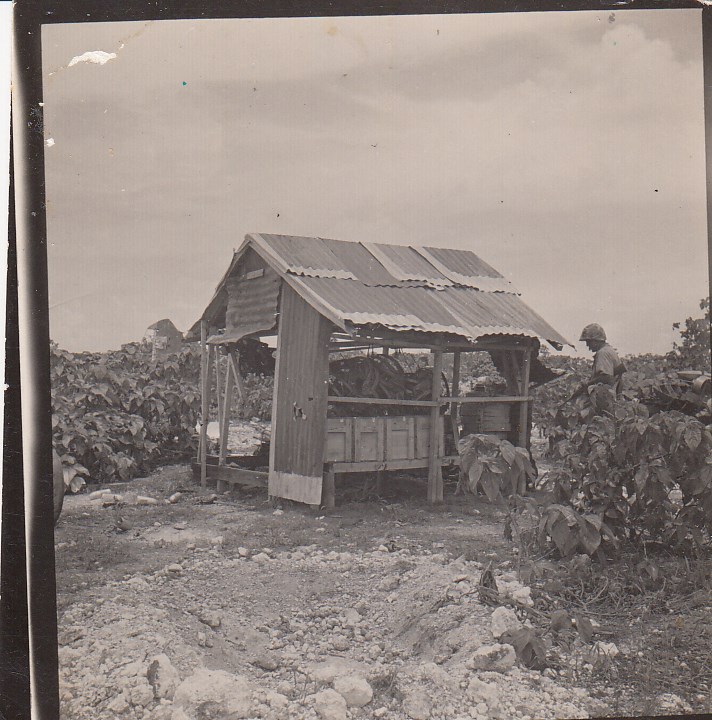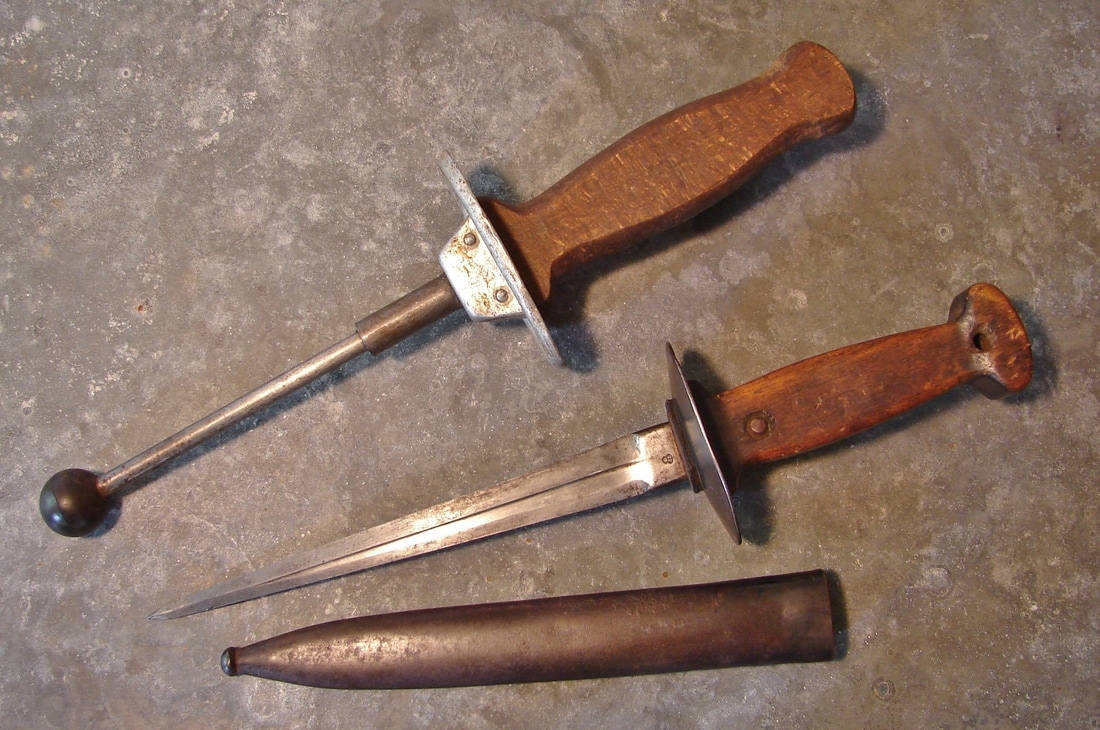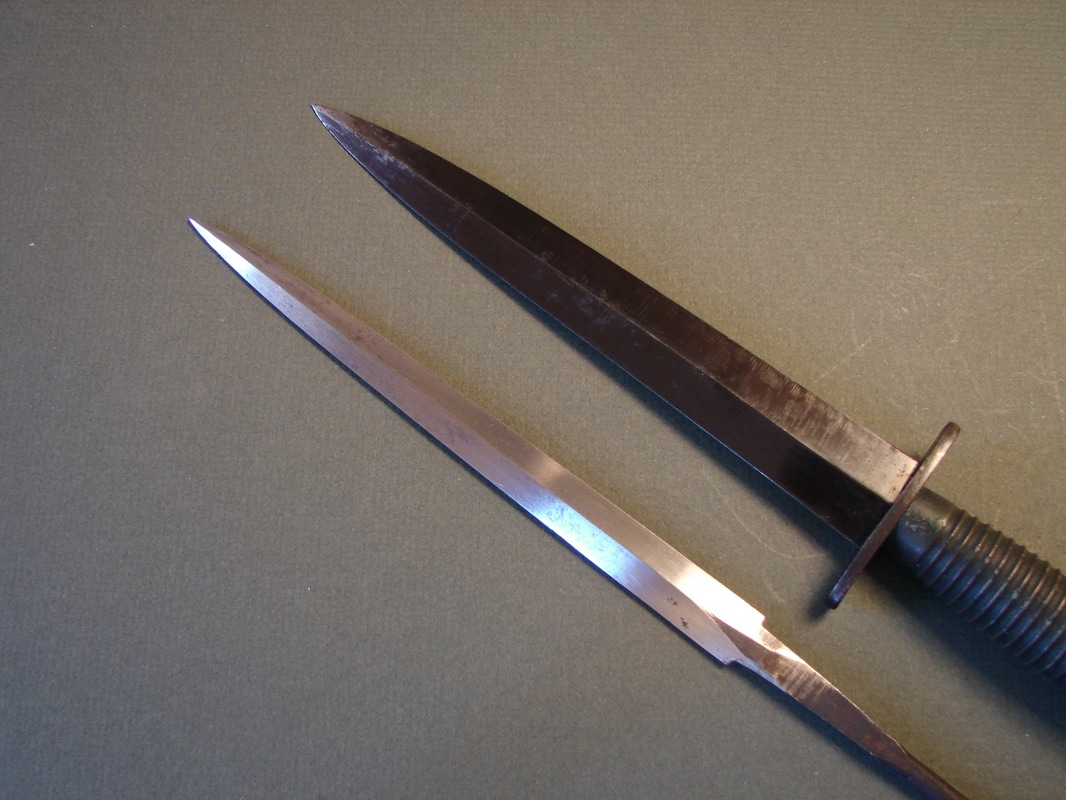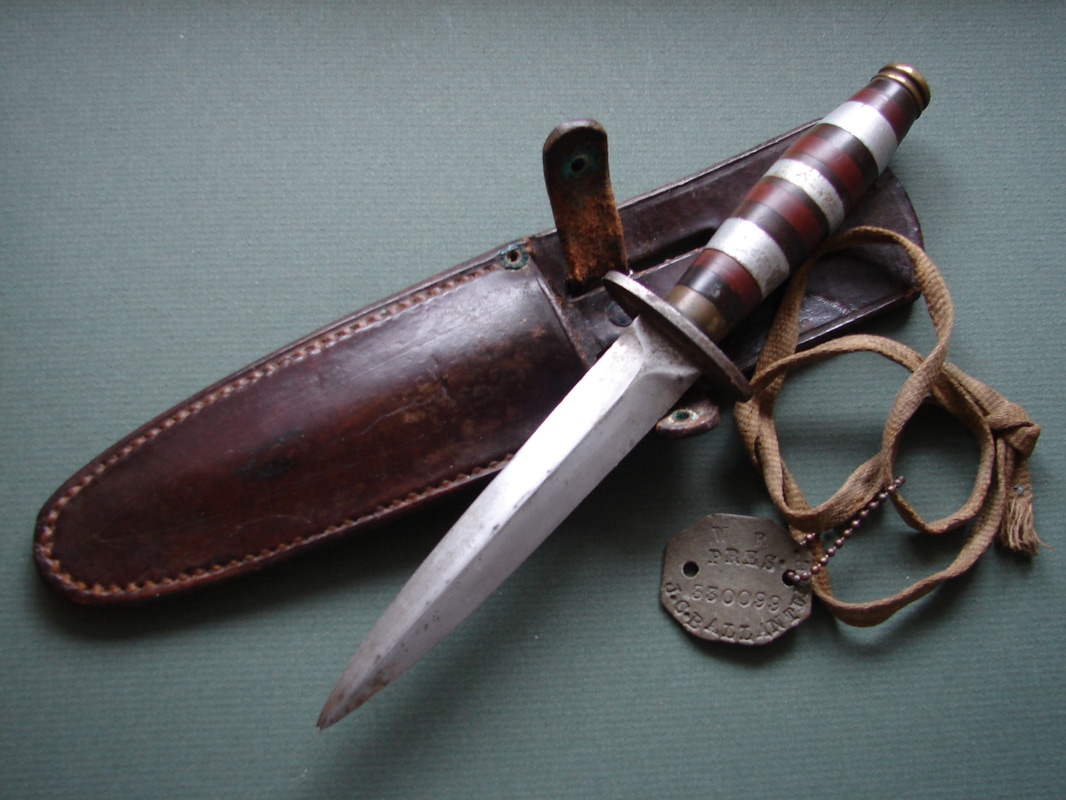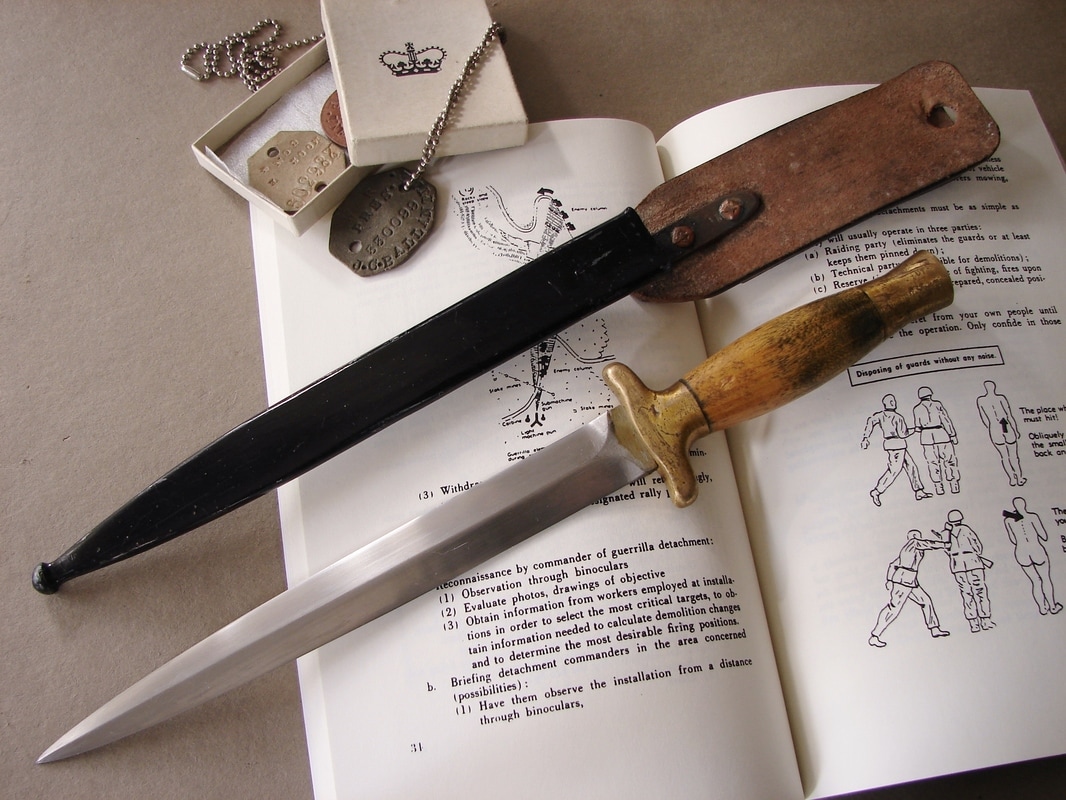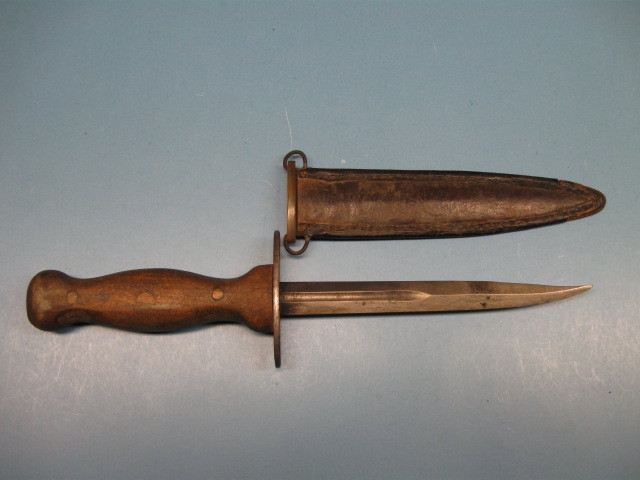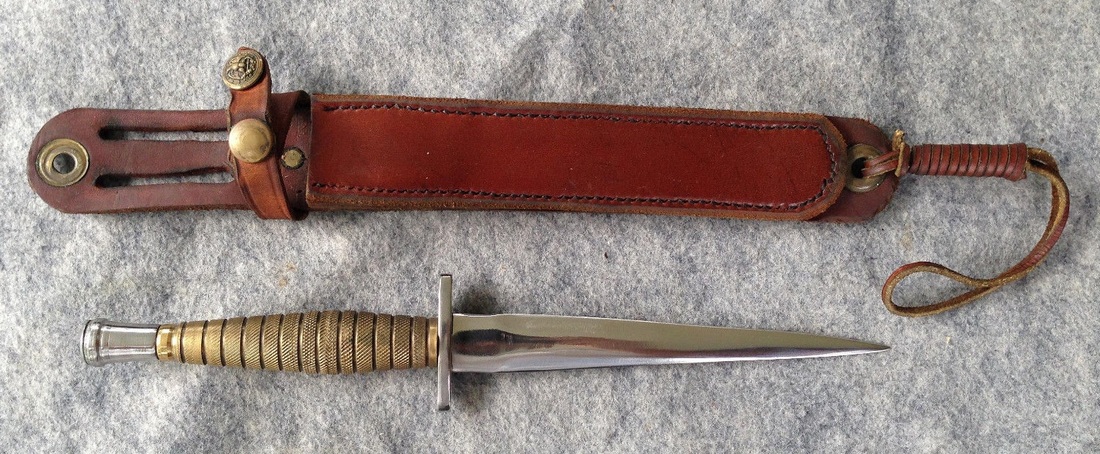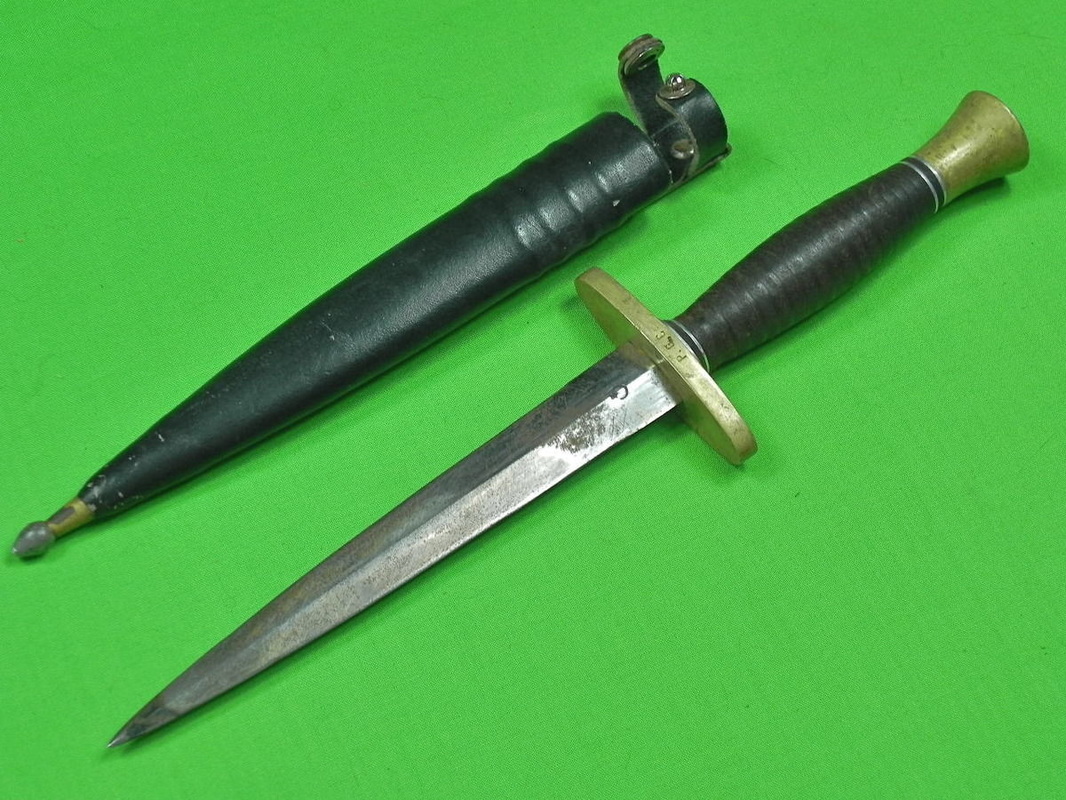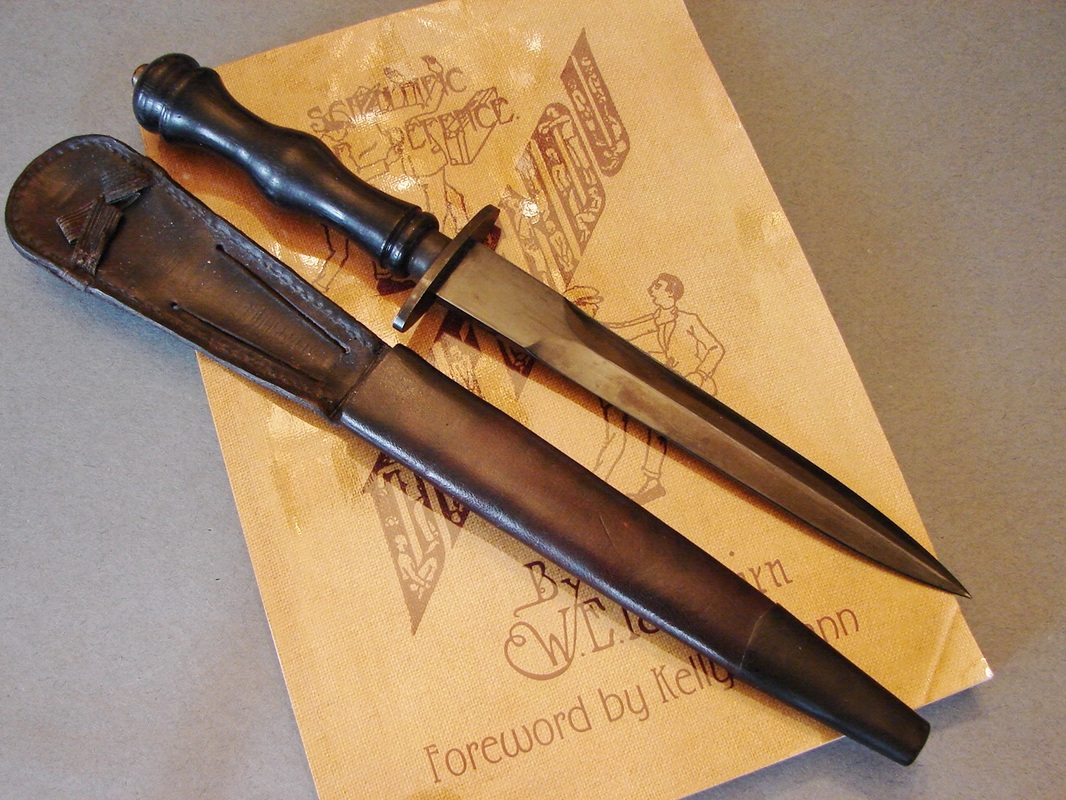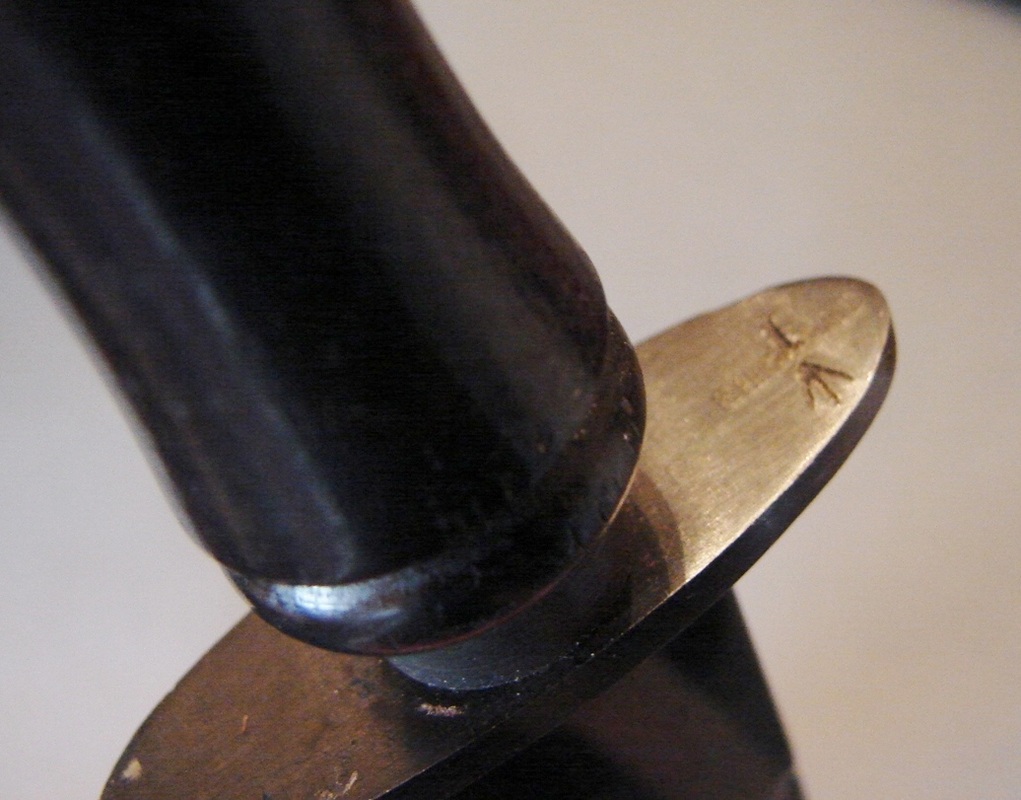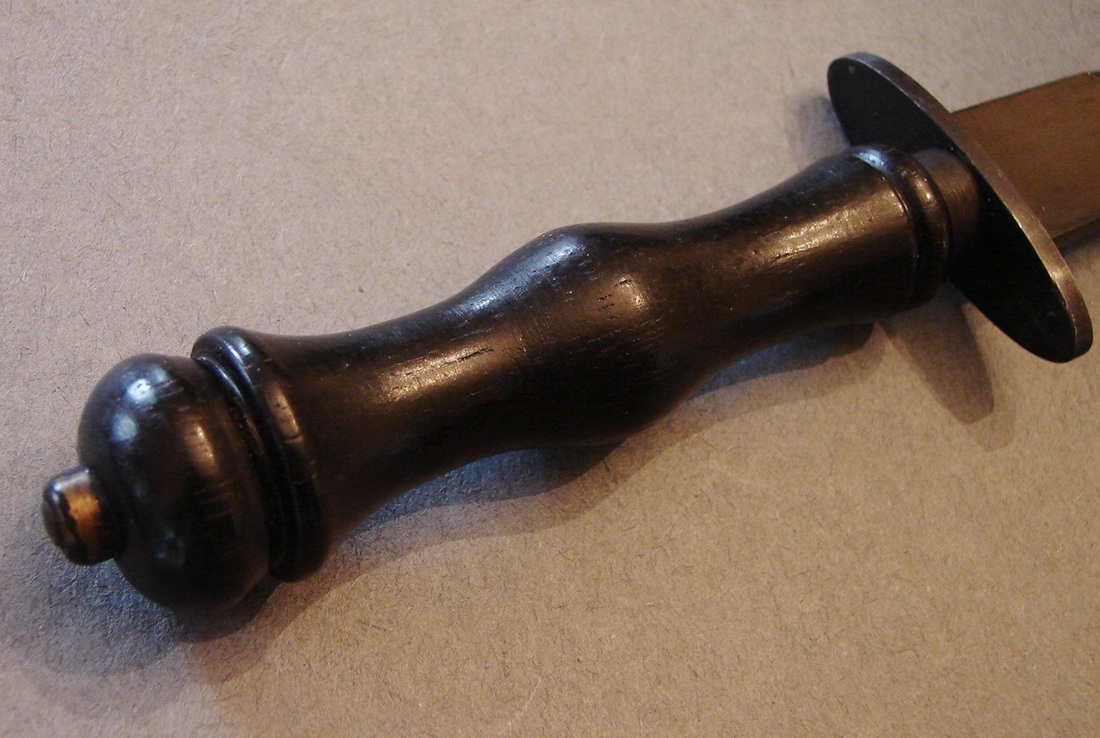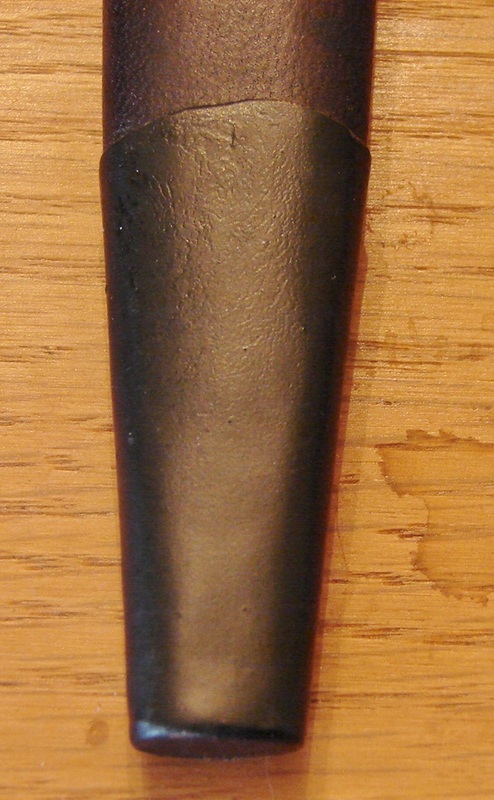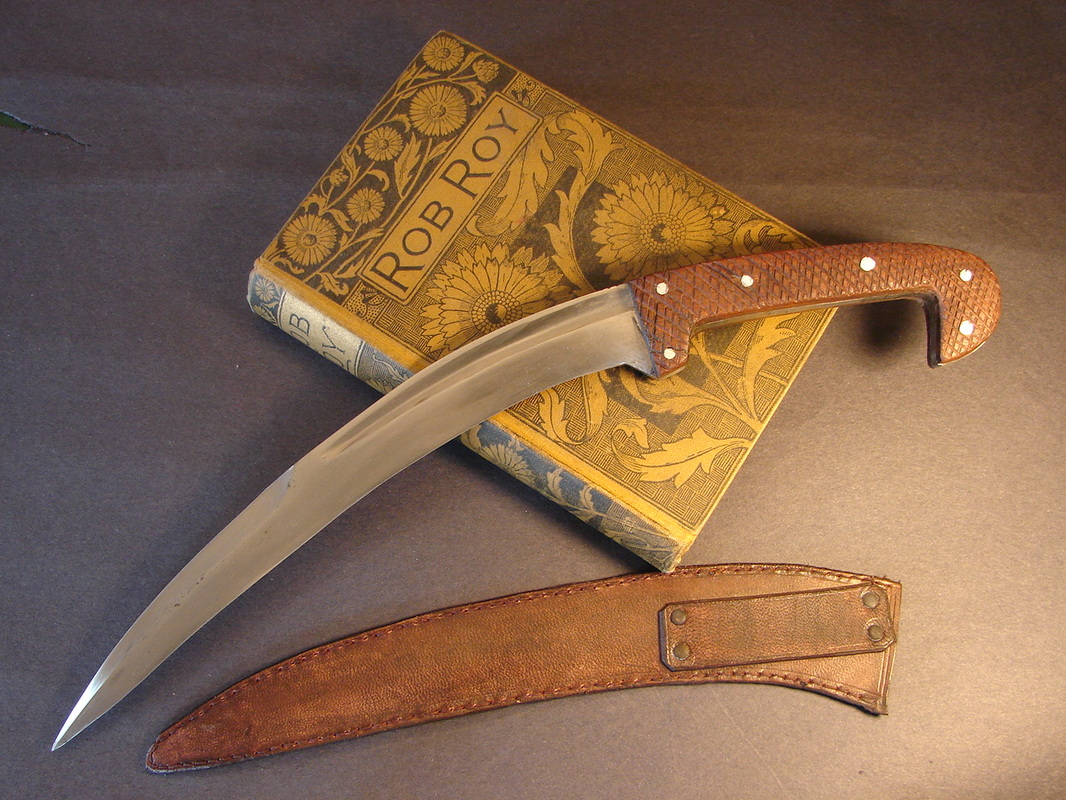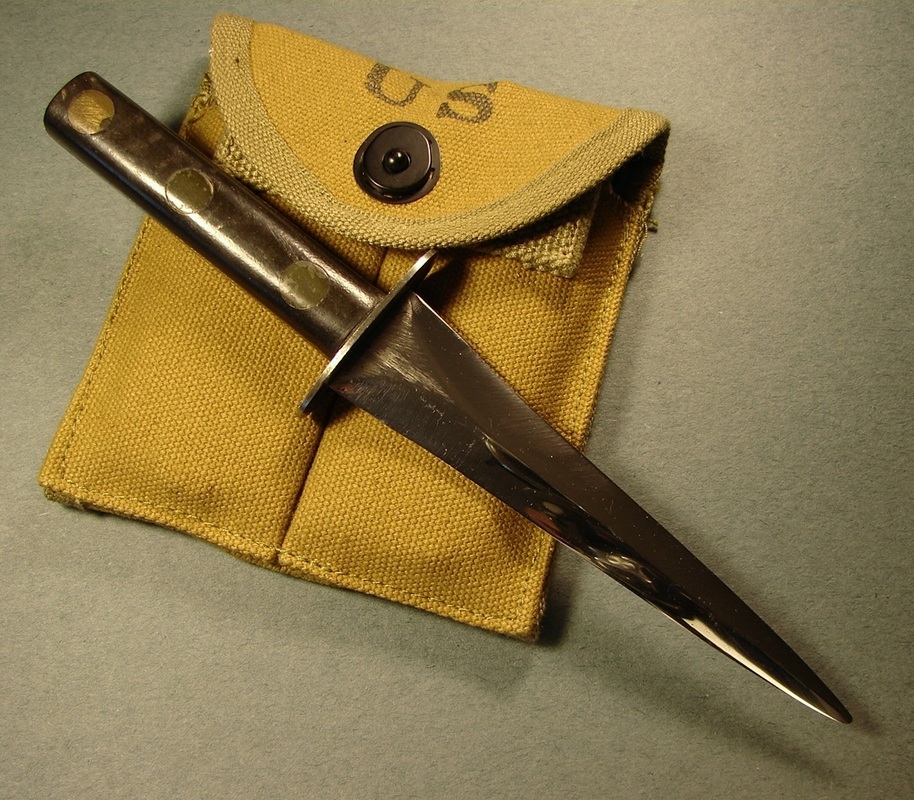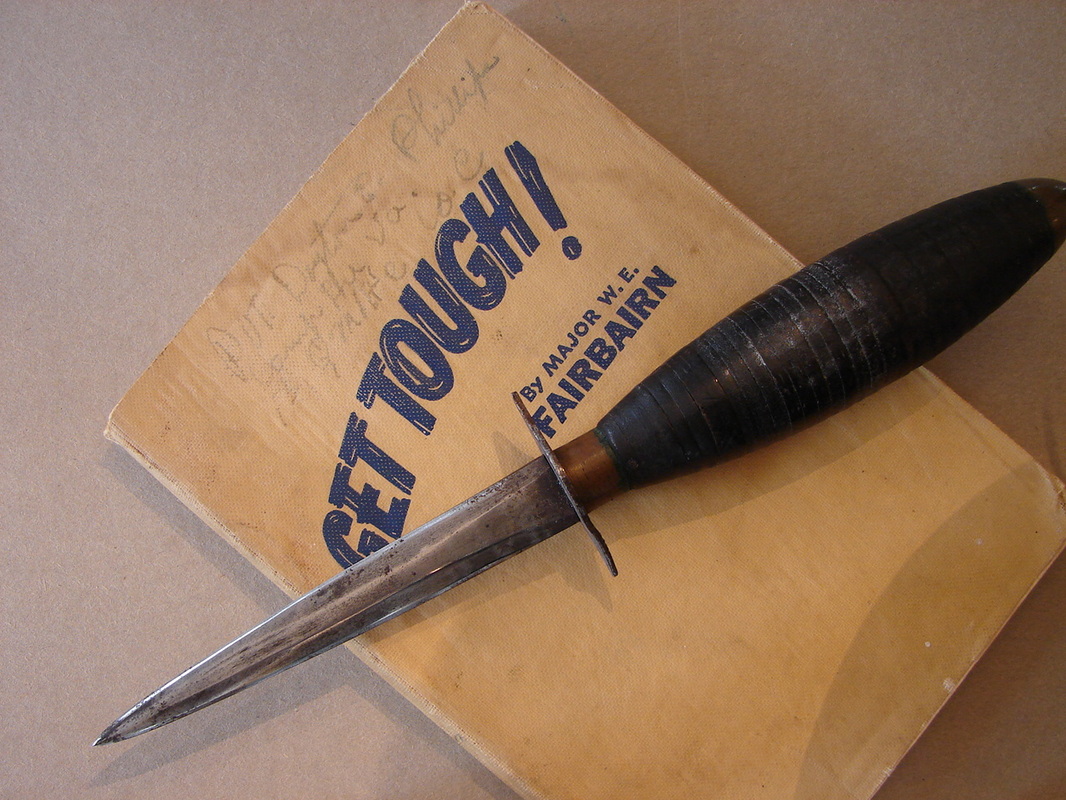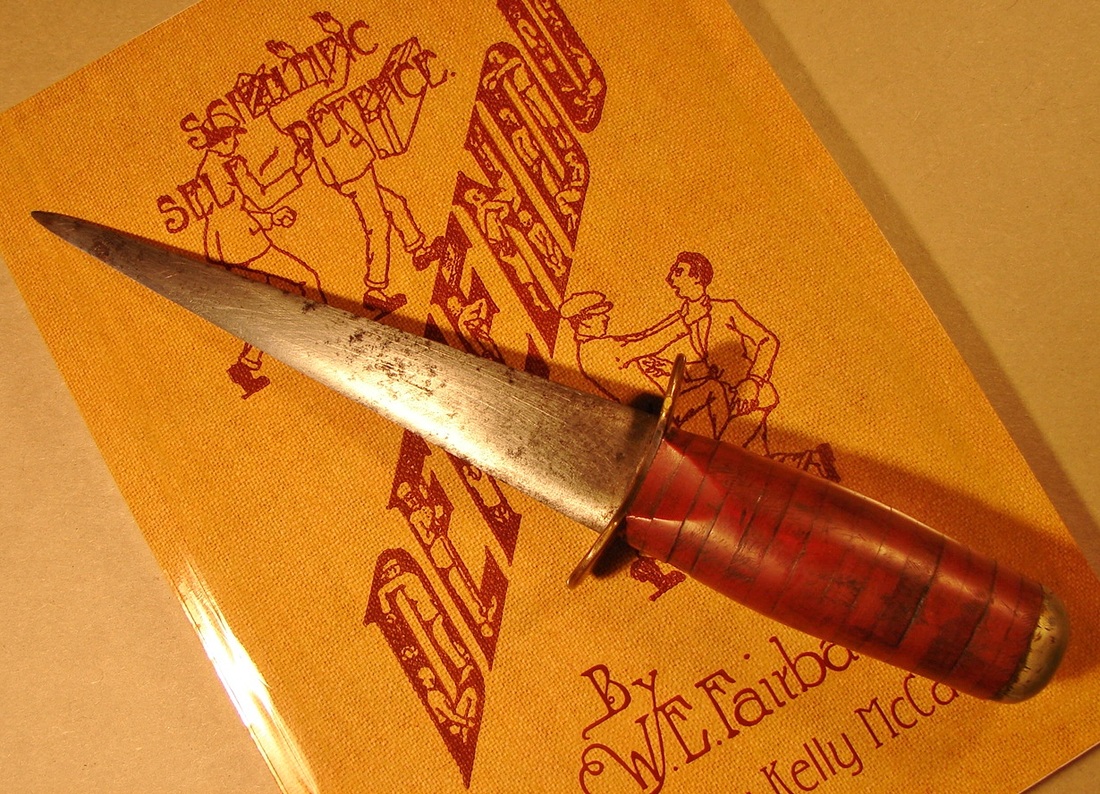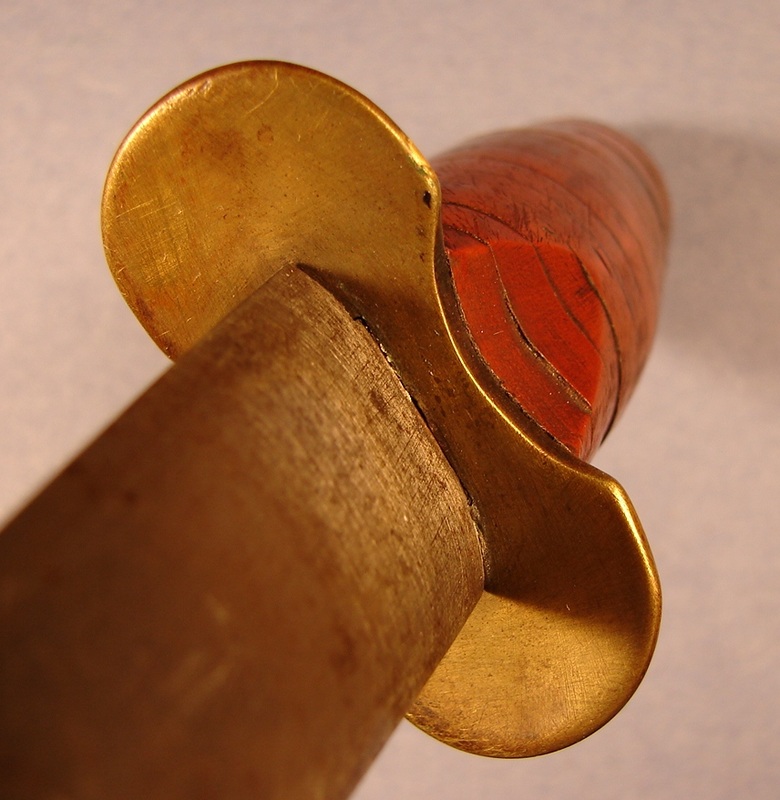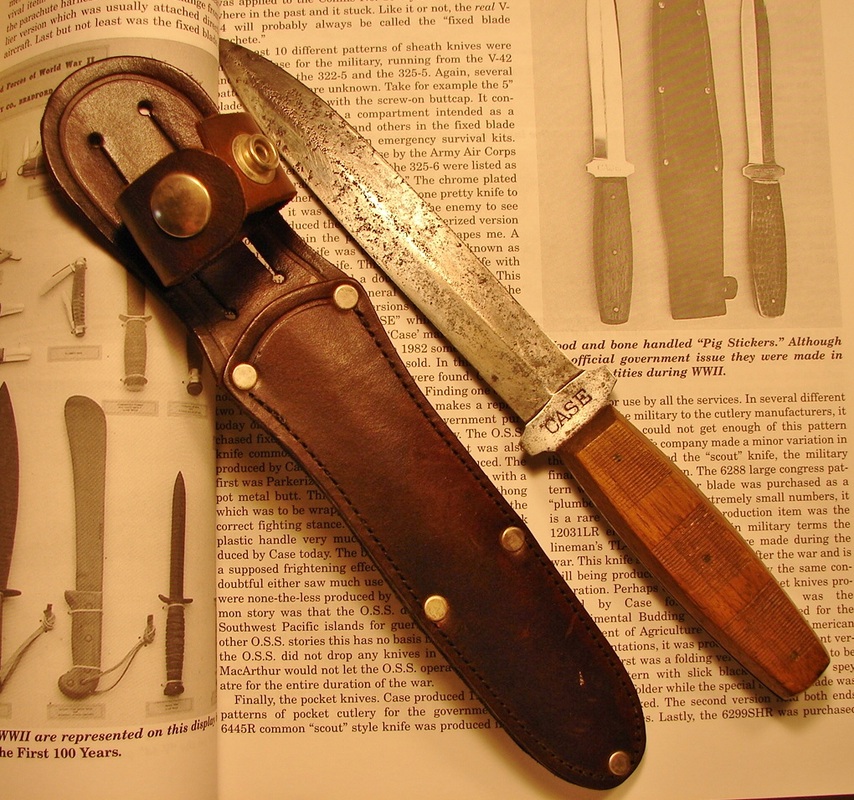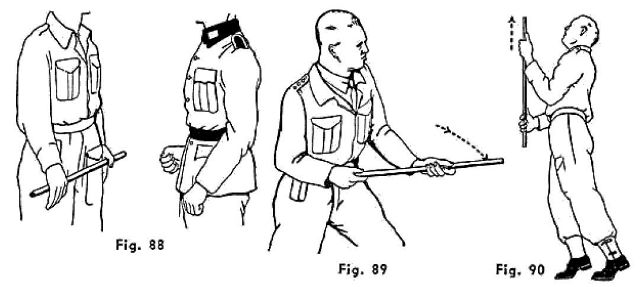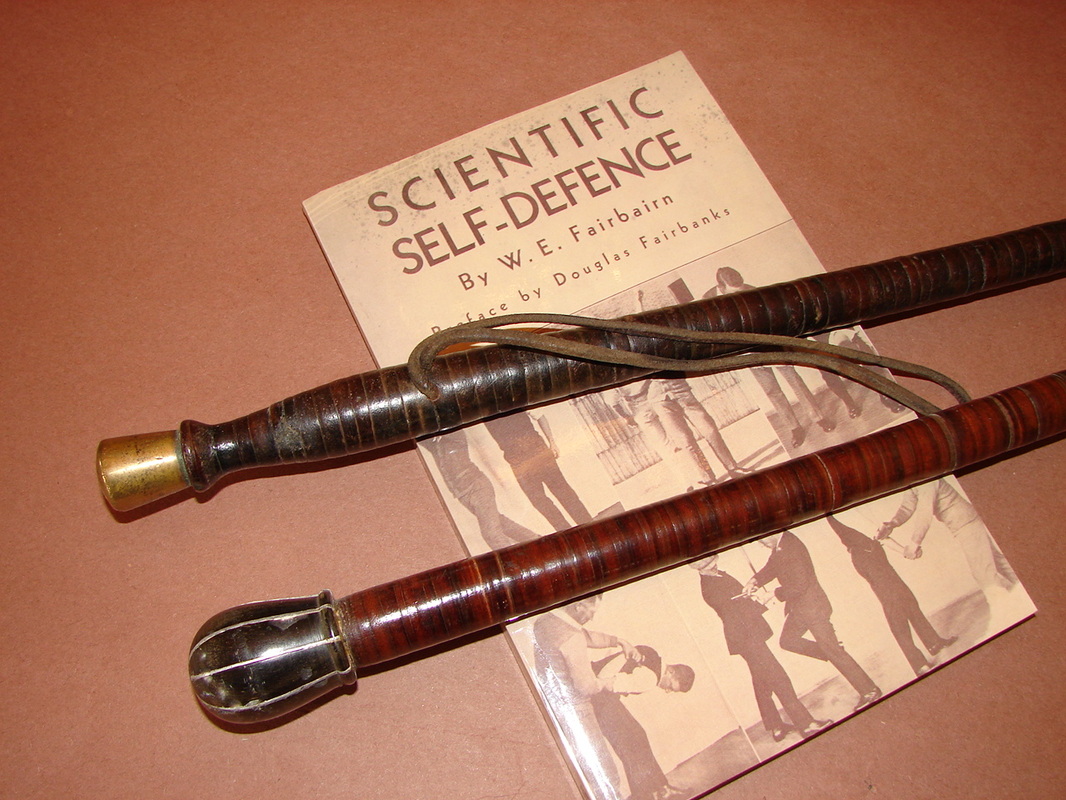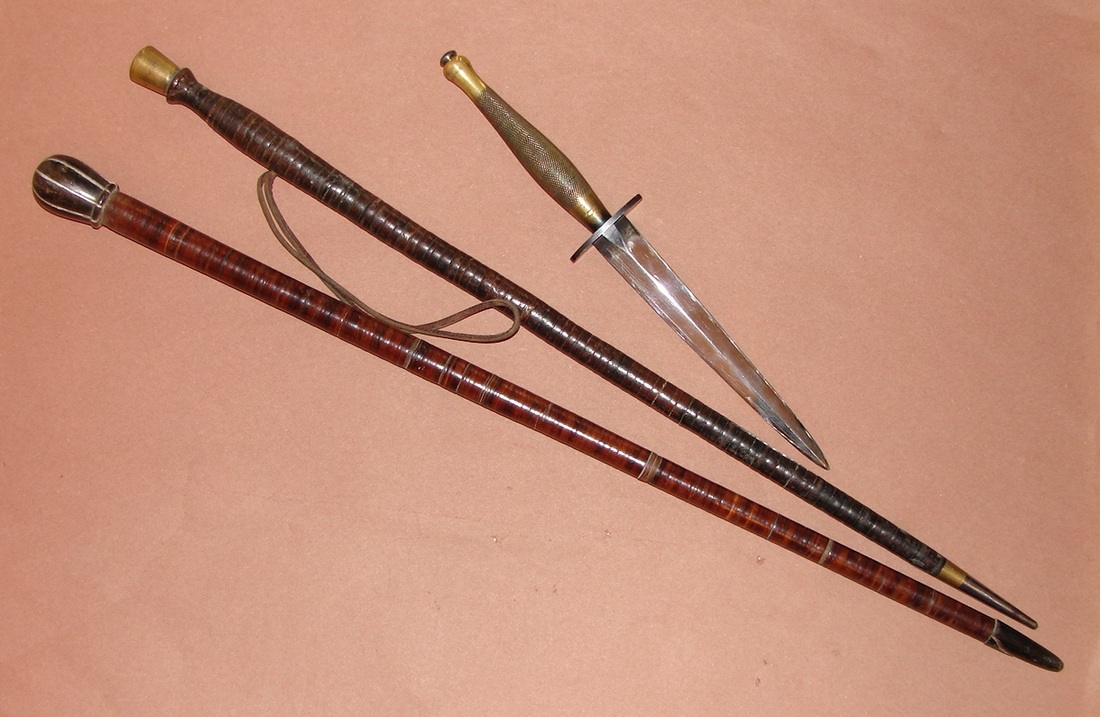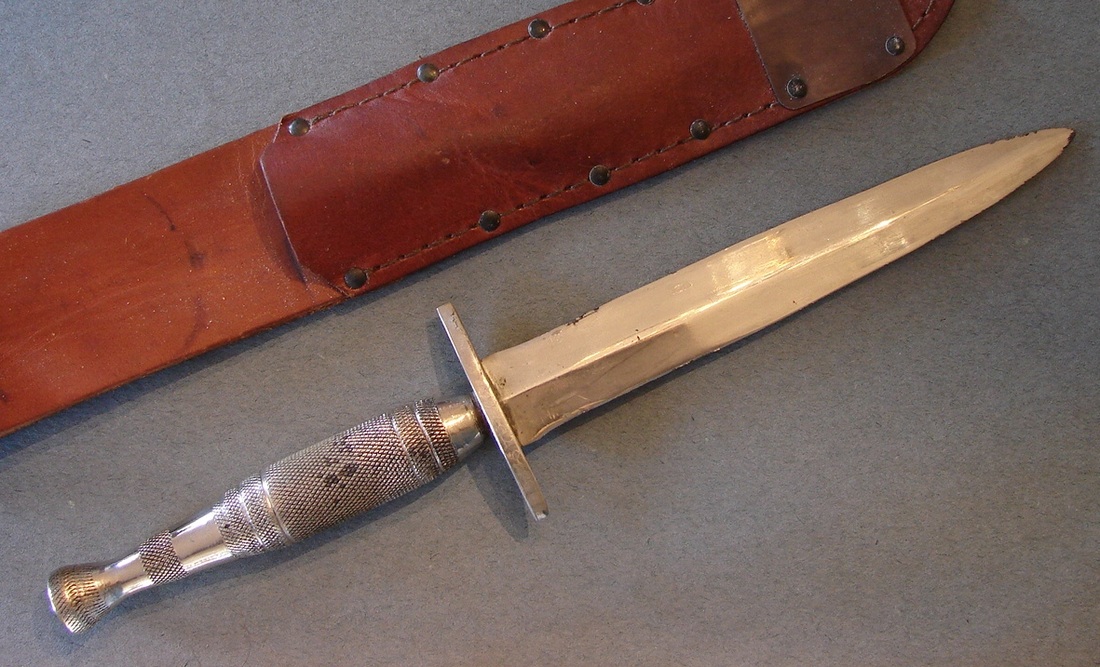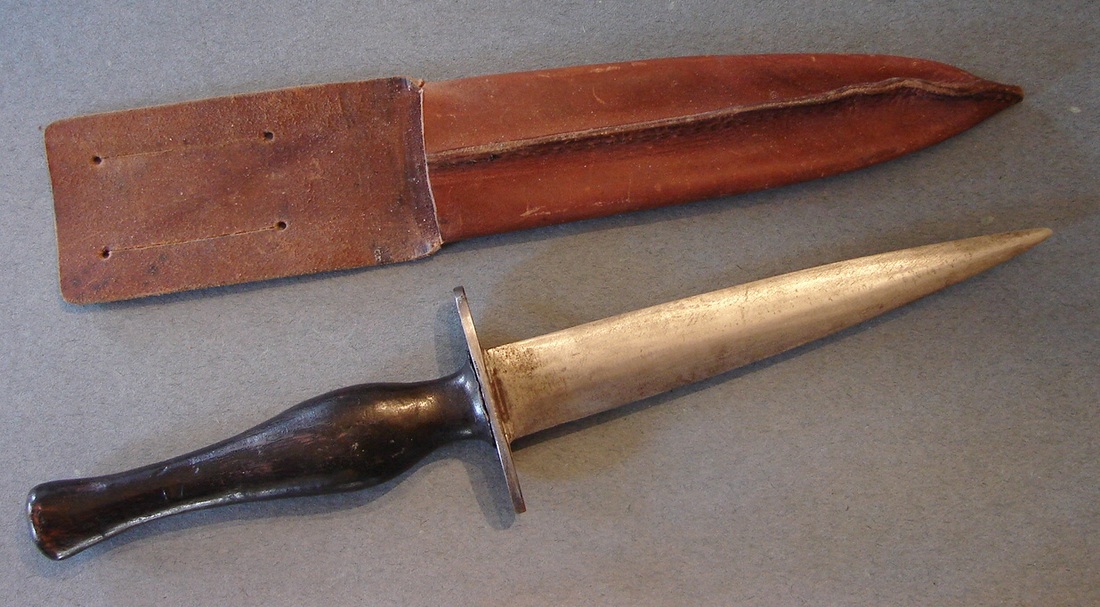Odds and Ends:
Miscellaneous Knives and Weapons Representing the Era or the genre of the Fairbairn Sykes. If it doesn't fit anywhere else on the website you'll find it here
Miscellaneous Knives and Weapons Representing the Era or the genre of the Fairbairn Sykes. If it doesn't fit anywhere else on the website you'll find it here
Dave Beckerman: This mighty dagger belonged to a man named Beckerman. His name is engraved on the brass guard. The blade is about 8 inches long and perfectly ground. An over-sized guard was made from brass and has some wiggle now. Leather washers were skillfully shaped into a pleasing grip and then varnished. There is a thin brass butt-cap threaded onto the tang. Although professionally made, the sheath seems a little bulkier than necessary. Still. it is a nice vintage WW-II fighting knife and at a fair price. After jerking me around on timely shipping it, the seller refunded the $19 shipping costs.
An exciting new book on Camp-X & WW-II Clandestine Training in Canada
Here is the info. http://www.camp-x.com/mehbookboso.html Copy and paste into your browser :
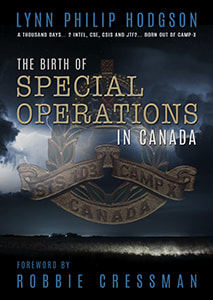
he book explains in detail the who/why/when/where and how William Stephenson's BSC - British Security Co-ordination was established in Canada and the United States, at the start of WW2.
It explains why Camp-X (STS 103) was created, it's purpose, the relationship with the United States. The relationship between Stephenson, Donovan and J. Edgar Hoover and the successes and failures of his operations.
Many people aren't aware that some of the very first COI and OWI agents were trained in Canada at STS 103 long before any of the American schools were established. In fact, once it was decided to create the schools at Camp David and the Congressional Golf Course, the instructors from Camp-X were seconded to the OSS to recruit and train instructors for the American schools. It's a must read for anyone who is interested in the subject of Special Operation and how and why it was created. Lynn Phillip Hodgson
It explains why Camp-X (STS 103) was created, it's purpose, the relationship with the United States. The relationship between Stephenson, Donovan and J. Edgar Hoover and the successes and failures of his operations.
Many people aren't aware that some of the very first COI and OWI agents were trained in Canada at STS 103 long before any of the American schools were established. In fact, once it was decided to create the schools at Camp David and the Congressional Golf Course, the instructors from Camp-X were seconded to the OSS to recruit and train instructors for the American schools. It's a must read for anyone who is interested in the subject of Special Operation and how and why it was created. Lynn Phillip Hodgson
Two Below: These are the "Odd Couple" of daggers. They are two different versions of "Orde Daggers." It has been a week or more and no one has recognized them on my blog. They are named after General Orde Wingate. A British General, Wingate led his troops against the Japanese invaders in Burma. Traveling from India into the mountainous jungles of Burma with mules and bullocks as transport animals. His men, called "Chindits," pushed the Japanese back out of Burma. The knives were donated to me by my Patron Saint of Knives. It started when I asked him if he had a photo of one. He asked: "Send me a photo of what you're talking about." He donated these from a box of "junk." He did say one of them might be a fake. Hmm which one? These were made by native Indian knife makers during and after the war. This is a photo of Orde Wingate during the India campaign with some of his Chindits.
UPDATE: The wooden handled dagger (right) bears a strong resemblance to one Mike Silvey lists in his excellent book on S.O.G. knives. He identifies his as a Vietnam era C.I.A. knife. I sent him a photo of mine and he says it looks like a copy. Is this what my donor surmised? Guess we'll never know for sure but I trust his integrity.
Below: Nicely made fighting knife converted from a 1943 M-1 Garand bayonet. The guard and handle are made from aluminum and pinned in place by steel pins. It is well constructed with no wiggles and a very sharp seven inch blade. While the sheath appears to be made for a single edged blade the knife and sheath seem to have been together for a long time. the blade is stiff despite the stock removal which thinned it considerably. It is also wicked sharp. The cross grooved handle is very comfortable and provides a nice, secure grip. (Just goes to show Ron, knives can be made from bayonets!)
It is hard to believe this double edged fighting knife was hand ground from this single edged bayonet, but that is what happened.
Below: Top knife is a second pattern style I believe was made in India. It was discovered in a box of O.S.S. stuff in an Indian warehouse. There are no identifying marks on it and the rough handle casting suggests it was not British made. The quality of the blade is excellent and still quite sharp. The bottom knife is generally referred to as an Indian Paratrooper knife. I placed them together so you could see the size comparison. I had always imagined the paratrooper knife to be much larger. It is well made and came with its original Enfield bayonet style scabbard. The handles looked to be a phenolic material but are actually a dense wood (I think). Someone ground a slight clip point on the end of the blade. The edge of the blade is nicely sharpened. This is a well designed and executed fighting knife.
After WW-1 Britain had done away with most of its instruments of war. When the second world war broke out there was a tremendous shortage of weapons of all sorts. Theater-made and homemade knives often had to fill the gaps that regular production could not. Conversions of kitchen knives, hunting knives, old bayonets and all sorts of "repurposed" tools were used by men on the front and especially in the home guards, also know as the stay at homes. A great comedy series called "Dad's Army" provides entertainment on Netflix. With the immanent threat of invasion from the German forces it was not a comedic situation but the Brits always rise to the occasion. This is the series melody taunting "Mr Hitler."
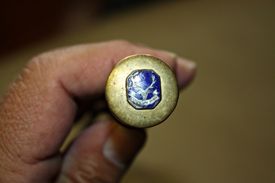
Below: To own one Faircane is a collector's dream. To own two is an incredible stroke of luck! My first one was bought over 20 years ago from a seller in Canada. This one came from an antique dealer in Nova Scotia. I just happened to look to on Ebay at the right time and Lady Luck was smiling on me. This one has the added benefit of having a regimental insignia soldered to the butt. It is in mint condition and tight as the day it was made. Faircanes are made up of a steel core that extends the length of the cane to end in a brass ferrule and a bullet shaped tip. The steel core is covered in leather washers and has a wrist strap. The heavy, solid brass knob makes both ends equally deadly. There are a lot of swagger sticks out there but 99.9% of them are not Faircanes! If you note, the handle is shaped similar to a F-S knife.
The crest reads: "Cuidich 'n Righ. This is Gaelic for "Help the King" and is the motto for the Queen's Own Highlander(Seaforth and Camerons) and subsequently The Highlanders."
The crest reads: "Cuidich 'n Righ. This is Gaelic for "Help the King" and is the motto for the Queen's Own Highlander(Seaforth and Camerons) and subsequently The Highlanders."
Below: Here is an unusual F-S style knife made by Wm. Menke & Co. that was found in a northern European forest by my friend Vincent van der Voet. I am researching the company so if you have any information to share I would appreciate it. I made the sheath for it in a typical commercial flat style. it is shown beside an original mini-dagger for size comparison. The only information I have for the Menke company is as follows.
HM & CO - HILLS, MENKE & CO.
Birmingham, England
In business since 1892
HM & CO - HILLS, MENKE & CO.
Birmingham, England
In business since 1892
Below: I have often said I would never buy a commando knife with a 50 BMG cartridge case for a handle. Well I didn't. This is another of the knives donated to our collection! I must admit this one was nicely done and is very solid feeling. The sheath is very unusual, sewn to a heavy piece of canvas duck. The blade and guard are from a Second Pattern knife. Thanks KJF for this addition to our collection.
Below: A very unusual second pattern conversion performed by some soldier. It actually feels better in the hand than might be expected. The sheath is a US M-8, designed for an American bayonet or M-3 trench knife. Again, this knife was donated by my friend in California, as were the coin tire slashers. He wishes to remain anonymous.
Below: Massive theater-made knife found by a man known only as Uncle Roy "sticking in a dead Jap," on Pelileu Island in 1944. The knife is very well made and has a 9.5" blade which is still very sharp! The leather washer handle and copper guard are tight with no looseness. The guard was soldered in place and a copper pommel looks to be completely covered in solder. Unfortunately the original sheath probably was carried onward in the advance as some hapless Marine left this glorious knife behind. It balances in the hand right before the guard and feels weightless. Whoever made it had an eye for fighting knives and did a wonderful job. I could not resist buying it since it had the second owner, "Uncle Roy's" letter describing how he came to find it during the battle. A man carrying a knife like this is a man to be feared. I have shown it beside my full-sized French Baroud knife for a size comparison. It has the feel of a small Scottish dirk. I have also included some photos (presumably from Pelileu) that accompanied the knife. Not exactly Gilligan's Island.
Below: WW-II Belgian fighting knife made from a cut down WW-I bayonet. It is illustrated alongside the spring loaded training knife used to train the troops. The ball-tipped blade slides into the handle upon contact and springs back. The dagger is quite a wicked piece of steel and would penetrate quite easily and deeply. The thin sheet metal guard is similar to that found on a fencing foil. The rudimentary wooden handles appear to be made from Beech.
Below: I am trying to find out who might have made the skinny blade. It is shaped just like a second pattern blade but obviously only half as wide. It is a factory made blade and very precisely ground. If you have any ideas please contact me. One person who has two similar blades said he was told they were British and made for the Home-Guards. That is not gospel folks, just what he was told and relayed to me. He owned one and had seen photos of others. It definitely looks British. A standard F-S guard fits it nicely.
Below: Small theater-made knife with a five inch blade. This knife has a very professionally ground blade with symmetrical bevels and a nice ricasso. It has an F-S style iron guard and a brass pommel neatly shaped. The sheath is also a high grade item with the snap no longer intact. A nice little stabber from WW-II
It's always a toss-up where to place knives like this one. It came from a collector in Norway. I'll let him tell the story, short as it is. "I bought this dagger for many years ago from the family of a retired Norwegian officer, passed away, along with an FS 3.pattern. The only thing they said is that he escaped to England in 1941 and returned to Norway as an SOE officer in late 1943." Jørn Eik-Nilsen. The knife bears a striking resemblance to a Gerber MK-II. I thanked Mr. Nilsen for being so patient while I made my decision and sent him some money. His response was a welcomed one. "No problem my friend, you have one of the best websites in the world." That's a comment we love to hear but I must say our visitors are also the best visitors in the world!
Below: Another new addition that is not an F-S but still an interesting fighting knife made from a piece of a Patton Saber. The post WW-I sword blades were cut down to make fighting knives during WW-II. The most desirable of them being knives made from the tip of the blades like this one. This is quite a nice example, a product of San Antonio Iron Works. It is dull as a rock though so don't expect to do any slicing with it. Anderson fighting knives also used sections of Patton sabers.
Below: I suppose I could have placed this knife in the custom category. Clearly a handmade knife in the F-S style. On the back of the sheath it is marked, "JV Simmons 2011." I presume this is the maker but it could just as well be who it was made for. It is quite attractive with its handle turned of brass and expertly knurled. A pommel section of polished steel makes a nice contrast. The guard is steel and well shaped and fitted. The maker (who must have been a machinist) was less versed in grinding blades and in cross-section it is not diamond shaped but a flattened ellipse. The edges are sharp enough to cut, and the point will certainly do its job! I would proudly carry this knife into combat. An Update: Hello, I was looking through your site and discovered a picture of one of the first knives I made (j.v. Simmons 2011). Mr. Simmons advised me the blade is not thoroughly heat treated, so best not to take it into combat. LOL I was "locked and loaded" and ready to go! Hey J.V. I still love the knife.
Below: I watched this knife go around and around on Ebay for many months but I always had another knife I wanted more. I finally decided to buy it before it disappeared. It is a Turkish F-S style knife from WW-II era?? Dating it may be impossible unless someone on here sees it and knows more about it than I do. One authority suggests it may be Korean War vintage. The handle is nicely shaped from leather washers with a couple aluminum spacers. It is capped with a graceful flaring pommel and a heavy brass guard. The sheath is made from a nice piece of leather and tipped with a small finial shaped fitting. If you know anything about this style knife or a Turkish Unit with the initials P.G.C. please email me. Note the blade is stamped with the Muslim Crescent moon and star. Maybe that will help determine what military unit carried these.
Below: Here is a new knife from country unknown. Based on past experience I would normally say Egypt, but there are some things that make me think India. Obviously it is the same as the knife illustrated in the group photo (or is it?) and which Homer Brett attributed to Egypt. The handle is identical in shape to the knife in the group photo but about a 7/8ths size. Considering the mint condition I wonder if this knife has been refurbished. It has a deeply blued blade and black painted handle. The sheath is in mint condition, and although extremely well made, does not appear to be British, the chape being the giveaway. It is made from very thin metal and the top is not evenly radiused. The back seam shows no indication of ever having sew tabs but the overall workmanship is impressive. Also, the traditional F-S steel guard is stamped" ^ I" and "England. This really confuses the issue. Was it reconditioned here in the US, postwar (the England only being stamped on imported knives) Or, was it converted in India during the war and imported afterwards. Whatever the true story, it is a nicely made fighting knife in the presumed "Egyptian style."
Fairbairn Cobra Reproduction: Do you recognize this knife? If you do not, do not feel bad. It is the last knife designed by Wm. E. Fairbairn and this fine copy was handcrafted by MacDonald Armouries, Edinburgh, Scotland. The Cobra was purportedly designed by Fairbairn for use by the Police in Cyprus, post WW-II. Exactly what caused him to diverge so far from the F~S fighting knife format is a mystery to me. Perhaps the Cobra was an extension of his studies and training with the Smatchet and the sleeker version of it called the Fairsword. A manuscript exists which was written by W.E. Fairbairn detailing the methods and training curriculum to be used with this weapon. Unfortunately the drawings referred to in the manuscript are not appended to it. I have experimented with this superb copy, created by Maestro Paul MacDonald, and I have found it to be a very formidable cutting and thrusting weapon.
|
Below: This interesting little dagger may have been made from a bayonet. It has a five and one half inch blade with perfectly ground bevels and a high polish. Whomever made it was a skilled craftsman. The handle slabs are secured by three rugged rivets. The oval shaped guard is like that of an F~S and appears to be made from nickle silver. Often referred to as "theater-made knives," this one is well above average in construction.
An update on this dagger: A closer inspection with a magnifying
glass seems to indicate it was made from a file! One of the flats near the guard has very light marks left of the file teeth cross-hatch pattern. It must not be from the very tang end of the file or else the tang would be too narrow to drill for rivets. Below: another Odds and Ends dagger from the war. Very well made sticker, no cutting edges. Leather washer handle with brass mounts. Some of this style dagger were made from sharpening steels used to sharpen butcher and meat carving knives.
Below: This handmade knife is something of an oddball. For some reason it feels Italian to me. I have no solid information to justify that premise. The handle is composed of washers of some sort of hard rubber-like material. It is fitted with a heavy brass pommel and a unique brass crossguard. In fact it was the cross guard that sold me on the knife. Whomever made it recognized the value of a large guard, but also the thumb recesses to help the user orient the blade without having to look.
Below: Illustrated here is a Case "Pig-Sticker." Originally used in the slaughter houses to kill pigs, it became a popular knife to carry afield in Battle. Full tang construction made it tough and reliable. The sheath shown here is a reproduction but made in the correct style. |
Fairbairn Fair-cane:
Officers of the WW-II era often carried riding crops or sticks of simillar size. In America they were sometimes referred to as "swagger-sticks". One that I own came from Canada and was associated with Camp X. These sticks were not just for show, but were suitable for putting up a solid defense against an unarmed man or a man with a knife. Called a "Fair-cane," the shaft has a steel core covered with leather washers that extends the full length terminating in a bullet shaped tip on one end and a heavy brass pommel on the top. Fairbairn taught the value of carrying and using a short stick, cane, or umbrella to put up a defense or to kill an opponent. The Fair-cane pictured here (top) was purchased along with a First Pattern F~S, belonging to the same veteran, both came from the Camp-X area. If only these items could talk. There is no solid proof, and the seller could not guarantee they were carried at the STC103 training center. Whether they were or not does not make them any less exciting to me since they were carried by a WW-II veteran who would have been an officer.
The bottom stick was a gift from a good friend. It is constructed of a steel core with leather washers and a knob and tip made from buffalo horn. This suggests manufacture in either India, SE Asia, or the Philippines as place of origin. The next photo shows the two full length with a WW-II P-2 for a size comparison. the Second Pattern B2 knife is twelve inches long.
Below: Here is another example of a "Theater-made Knife." It was quite well made during WW-II and is crudely engraved on the guard and pommel "M.A. Stowlove MD." The handle and guard are steel. The entire knife is nickel plated. The handle is shaped like those attributed to Australia, India or even the Vietnam War 5th Special Forces knife. This knife handle has a very "Indian" flair to it.
Not everyone could afford, or had access to, a genuine Fairbairn Sykes. They had to make do with homemade or theater-made knives like this one. Made from a file, with a simple wooden handle it would work for stabbing but the edge is nearly useless. File-made blades were often too soft or too hard and brittle. Heat treating blades in a combat zone is hit and miss.
|
